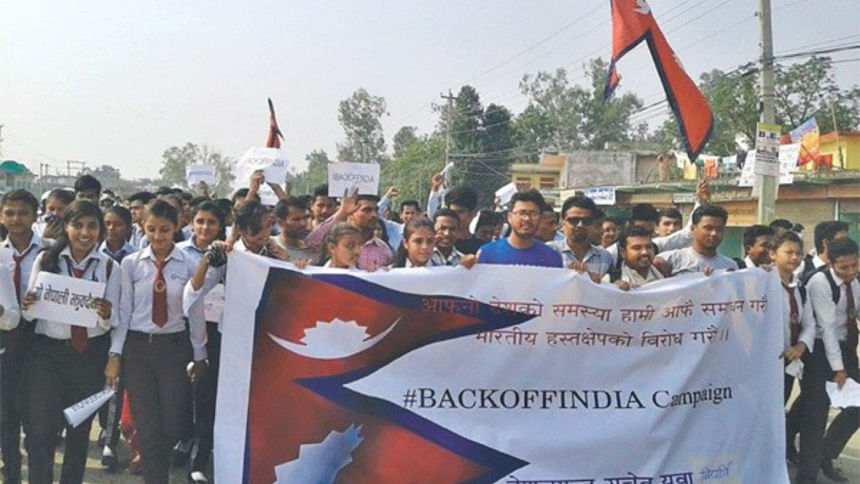Nepal in a straitjacket

A curious situation has been developing on the international border between two South Asian neighbours – both of whom are honourable members of SAARC. Nepal is a landlocked country bordered by India on the south, east and west. China is on Nepal's north. The country is heavily dependent on its neighbours for transit and supplies.
On September 25 this year, Nepal, after seven years of controversial deliberations, passed a new constitution which ensures democracy and secularism. But prior to the signing of the new constitution, violence broke out between Nepalese security forces and a crowd of Madhesi people who are of Indian origin. They were demonstrating in Birganj in the Parsa district of southern Nepal. Several people had been killed in the clashes between these Madhesi and Tharu ethnic groups over changes in territories in Nepal and new election rules. The Madhesi people staged a 40 day sit-in and also triggered a fuel blockade that left over 200 fuel trucks stranded on the Indian border. This paralysis on the border crossing, which in fact is the main supply route to Nepal's capital Kathmandu, resulted in crippling fuel shortages. This was at a time when Nepal was still reeling from a devastating earthquake that occurred in April of this year. Nepalese police descended on the protestors and dispersed them. But they regrouped and burnt tires. Police then fired tear gas and charged on them. Subsequently in August, 40 protestors were killed by security forces. The protestors had been objecting to the new federal structure in the new constitution, which allowed people in the mountains to dominate minorities in the lowlands.
As the violence spread, India strongly denounced the allegations made by a Nepalese minister without portfolio that India was sending soldiers in plain clothes into Nepal to boost the claim of Indian origin Madhesis as 'provocative'. The agitation by these people took place near the main trading post Raxaul, thereby shutting off fuel supplies to Nepal which comes from India.
So what is Nepal likely to do if it cannot contain the Madhesis' unrest? India on its part says it does not want to prescribe any model to Nepal over its constitution. But it is worried about violence and instability in Nepal which, it fears, could spill over to India. It has therefore suggested that Nepal introduce a constitution that is acceptable to all sections and which does not sow the seeds of instability in either country. It has urged Nepal to address the demands of the agitating Madhesi people through dialogue.
Nepal now has to rethink her options in the face of fuel shortages. One option is to obtain the fuel from China in the north. But the road route to China has become quite hazardous after the earthquake earlier in the year. Nepal is now sandwiched between the proverbial devil and the deep sea.
India ought to reshape the contours of its relations with Nepal at a time when the former appears to be losing out to China. Nepal blames India for pulling the strings from behind the scenes. Meanwhile, Nepal is not waiting. It has recently signed a pact to import a third of the fuel the country needs from China, following Beijing's grant of 1000 metric tonnes of free petroleum as a 'goodwill gesture'. All this implies that slowly but surely Nepal is being driven towards China, marring its relations with its old friend India.
Today India's intervention in Nepal is seen as having a polarising effect on the Nepalese. In any case India should not be seen by Nepal as taking sides. It is likely to have a destabilising influence in the Himalayas. India is being self-contradictory by taking sides in the internal affairs of Nepal and thereby compromising Nepal's sovereignty. Indian Prime Minister Modi's much publicised 'neighbourhood first' policy is coming to naught. India should now refrain from being a polarising figure, and instead encourage both sides through quiet and sustained diplomacy to reach an amicable solution to the Madhesi problem. It is time it plays a constructive role and reverses the situation which it has inadvertently created. It should under no circumstances alienate the hill people of Kathmandu.
As a SAARC neighbour, Bangladesh can also play a discreet role in bringing the two sides closer again. It is indeed a test case for India. Bangladesh is also expanding her partnership with India in many spheres. We must wait and see how it plays her card with Nepal. On this will also rest India's future possibility of being a new permanent member of the UN Security Council. Many are watching its motives and moves. If it is unable to resolve her relations with her small neighbour Nepal amicably, questions will be raised later as to whether India can be a strategic player as a Security Council member in the world stage. It will also show how India under Prime Minister Modi has abandoned her old profligate behaviour and is now ready to play the role of a responsible and responsive neighbour to countries like Nepal, Bangladesh and even Bhutan. The world is watching.
The writer is a former Ambassador and a columnist of The Daily Star.
E-Mail: [email protected]

 For all latest news, follow The Daily Star's Google News channel.
For all latest news, follow The Daily Star's Google News channel. 



Comments